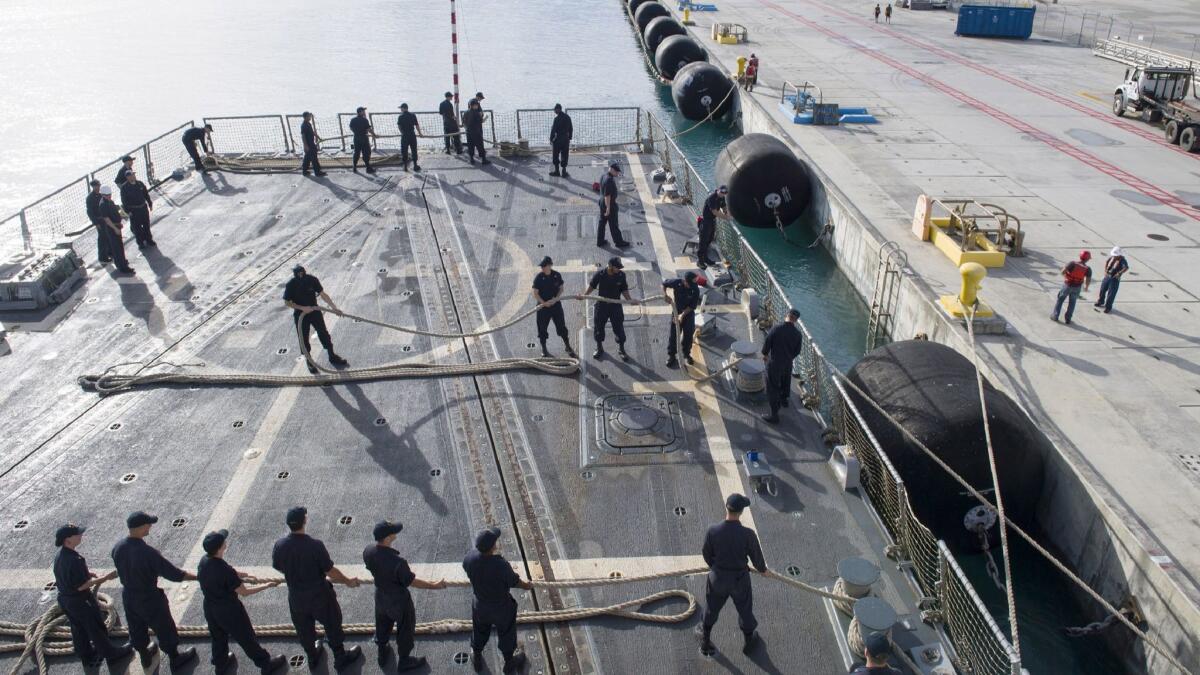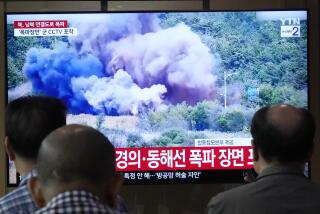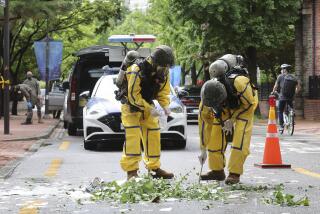Guam residents greet threat from North Korea with mix of worry and bemusement

English and Chamorro are the island’s chief languages, with Chamorro being its largest ethnic group. (Aug. 9, 2017)
- Share via
Reporting from Asan, Guam — Residents on this tiny Western Pacific island, a United States territory that is home to strategically important American armed forces, have grown accustomed to occasional threats.
There are the super typhoons and the occasional earthquakes and tsunamis — all of which have caused real anxiety here in recent decades.
But now there’s a specific and immediate concern: North Korea, which has threatened to direct an “encircling strike” into the waters around the island as a testing ground for its ballistic missiles.
The threat, and the rhetorical war it’s spawned with President Trump in recent days, has prompted residents here to lose some of their island cool.
“Do not look at the flash or fireball — it can blind you,” the island’s homeland security agency said in a fact sheet shared with residents Friday afternoon.
Even before the alarming message, there was growing concern across the island — home to 160,000 residents on a speck of earth about the size in area of California City (or Columbus, Ohio).
Take a Friday morning news headline: “14 MINUTES” — the time a presumed missile or missiles might fly from North Korea before impact.
“Why is such a small island, Guam, now under threat?” asked Jenntte Jain, 22, a local who works at a beachside market. “Why did Guam just pop up — like North Korea is going to be bombing? What?”
Like Jain, residents at all levels of society here have expressed a mix of worry and bemusement about being caught in the middle of North Korea’s threats, which come amid escalating tensions between the rogue nation and the international community.
“People are worried,” said R. Gary Hartz, an associate dean of technology and student services at Guam Community College. “People wish that there was not this kind of threat hanging over our heads.”
Hartz, a Tennessee native who moved to the island 15 years ago, said he has confidence his fellow Guamanians would help one another if the worst were to occur.
“I try just to continue to live my life,” he said. “But I’m aware of this low-level stress that’s there. You know, when you lay down on your pillow at night, and clear thoughts from your mind? There are more thoughts to clear today than there were a month ago.”
North Korea, considered by many security experts and American intelligence officials to be a nuclear state, has in recent months shown significant progress in its effort to build ballistic missiles capable of striking targets outside Asia, including the United States mainland.
Two recent intercontinental ballistic missile tests showed the technical ability, in theory, for missiles to reach Alaska or the West Coast of the mainland. These devices flew high trajectories and landed in the Sea of Japan.
Flatter flight paths could make them more threatening to extended targets, including, it now appears, the area around Guam.
A new round of international sanctions in response to North Korea’s recent tests has provoked renewed threats on both sides. Trump declared that “fire and fury” would descend on North Korea if it were to continue to threaten the United States, escalating the tension.
North Korea has twice said this week that it was examining a plan to test-launch intermediate-range missiles to land near Guam, a first for the government. The North, no stranger to hyperbolic or threatening language, used a term widely interpreted as “enveloping fire” but “encircling strike” is a more accurate translation of what it actually meant — as in striking with a missile.

Guam, with an economy that depends on tourism, largely from Japan and South Korea, both of whom also feel threatened by North Korea, now finds itself in the middle after U.S. bombers staged military exercises from here recently.
The territory’s governor, Eddie Baza Calvo, said in an interview Thursday that his administration has tried to remain “cool, calm and collected.” He said his citizens are used to threats from natural disasters — and can handle anything that comes their way.
“We’re very prepared, because of Guam’s nature,” he said. “We’re the most-prepared of any community in the United States.”
“The state of threat … has not changed since the bellicose statements of the North Korean leader,” he said.
“We are going to be making additional public outreach plans to ensure that the public is fully informed about all the contingencies in regards to any event, whether it’s a super typhoon or military event.”
That outreach included the fact sheet, released late in the day Friday, titled “preparing for an imminent missile threat.”
The local business community expressed confidence. Indeed, the nation’s airport this week has been filled with foreign tourists vacationing here.
“Guam is, and will continue to be, economically sound and is a safe and protected area to visit and do business,” the Guam Chamber of Commerce said in a statement. “We encourage members to stay diligent and make necessary precautions as any business would to protect the health and safety of its employees and patrons.”
The confidence projected by leaders could be because the threat of a direct missile strike, and the potentially serious U.S. response it could invite, remains remote.
And this isn’t Guam’s first experience with North Korea.
In 2013, a North Korean official said that Andersen Air Force Base — a U.S. facility on the far northeastern part of the island that houses long-range bombers — was “within range” of its missiles.
North Korea has also mentioned Guam in its statements reacting to sanctions more than a decade ago.
But something this time feels different, some residents say. And others are even more concerned about what the threat says about Guam’s place in the world — and where it stands in the United States’ hierarchy.
The small territory, which has a gross domestic product of about $4.5 billion annually, has an elected, non-voting delegate in the U.S. House of Representatives but is not allowed to vote in presidential elections.
Yet Trump’s fiery language — and the U.S.’s robust military presence here since World War II — opens it to threats like those from North Korea, however remote.
“If Kim Jong Un said he was going to hit Seattle or Anchorage, and the president says so, ‘Go ahead, and see what happens,’ I think people there would be pretty upset,” said Robert Underwood, president of the University of Guam and a former congressional delegate during the 1990s and early 2000s. “When you’re a territory of the U.S., it just points out what your role is.”
Stiles is a special correspondent.
ALSO
Trump says military ‘locked and loaded’ if North Korea refuses to yield
Russian lawmakers see Trump’s gratitude to Putin as a front to his displeasure
North Korea: What happens when the ‘fire and fury’ starts?
More to Read
Sign up for Essential California
The most important California stories and recommendations in your inbox every morning.
You may occasionally receive promotional content from the Los Angeles Times.














